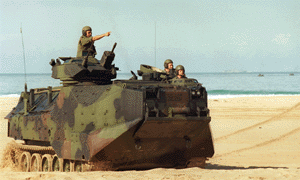The Marine Corpsí premier rapid reaction units are its seven Marine Expeditionary Units (MEUs). Three 2000-man MEUs are maintained forward-deployed aboard three-ship amphibious squadrons (Phibrons) forming task forces called Amphibious Ready Groups. (ARG)s One ARG is based in Japan, one is maintained in the Indian Ocean by rotating deployments among West Coast units, and another ARG is maintained in the Mid-Atlantic/Mediterranean region by rotating deployments among East Coast units. The Navy and Marine Corps can easily expand the number of combat-ready ARGs from three to five by forming two more MEUs and extending the rotational cycle for CONUS MEUs from 18 to 24 months.
 The CONUS based MEUs now undergo an 18-month deployment cycle which consists of three six-month phases. During the first phase, a MEU
just returning from deployment disbands, then reforms with new components.
During the second phase, the newly organized MEU undergoes intense training in
which teamwork and skills are developed. The MEU eventually earns a Special Operations
Capable (SOC) designation to reflect its high-readiness state. During the third phase, the
MEU (SOC) deploys overseas aboard a Phibron as part of an ARG.
The CONUS based MEUs now undergo an 18-month deployment cycle which consists of three six-month phases. During the first phase, a MEU
just returning from deployment disbands, then reforms with new components.
During the second phase, the newly organized MEU undergoes intense training in
which teamwork and skills are developed. The MEU eventually earns a Special Operations
Capable (SOC) designation to reflect its high-readiness state. During the third phase, the
MEU (SOC) deploys overseas aboard a Phibron as part of an ARG.
This cycle is effective, yet wasteful. The 12-month effort at
organizing and training a MEU (SOC) is lost after the six-month deployment.
This highly-trained team is disbanded as the infantry battalion, composite aviation squadron, and various support elements return to their parent
units. Only a couple hundred Marines in the MEU headquarters and MEU service support unit are retained as the teambuilding efforts begins again
with new components.
MEU (SOC)s could be available for crisis response for a
year if a fourth six-month "ready" phase were added. Upon completion of the second phase in
which a MEU is fully trained and SOC qualified, it would not deploy, but stand ready on
72-hour alert. The ARG ships would remain in port loaded with the MEU (SOC) supplies and most
equipment. The ready MEU (SOC) Marines would live in their quarters ashore and conduct some local training. They
may embark for a few short ARG exercises, but most nights will be spent at home on an alert.
This "ready" phase will allow most nights at home to compensate
families for the previous six months of intensive training and the forthcoming
six-month deployment.
Current 18-month Atlantic MEU Cycle
22nd MEU refit > 24th MEU train
> 26th MEU (SOC) deployed
Proposed 24-month Cycle
22nd MEU refit > 24th MEU
train > 26th MEU (SOC) ready > 28th MEU (SOC)
deployed
Normally, the "ready" MEU (SOC) will spend the entire six-month
alert phase at home. However recent history suggests that they may often deploy into the fourth phase early. Since the end of the
Cold war, the deployed Atlantic MEU (SOC), has been needed in the Persian Gulf, off
Bosnia, off Western Africa and in Haiti. These demands have required the formation of awkward task forces.
A MEU (SOC), which just returned from deployment was reassembled and sent to Haiti.
In other cases, MEUs in training were deployed early, while other MEUs were divided into "split"
ARGs. A 24-month cycle will provide a "ready" MEU (SOC)s on 72-hour alert
to respond to occasional demands more ARGs.
Five well-trained MEU(SOC)s will also enhance the Corpsí ability to
rapidly amass a large amphibious force. The last attempt occurred during August of 1990 when the 4th MEB (equivalent
to three MEUs) was formed. It took over three weeks to assemble and embark units aboard 13 ships. This
unit had no full-scale training opportunities prior to deployment, and embarkation was a mess. Tons
of gear was left on the pier and the improperly loaded ships were required to dock and reconfigure after
arriving in the Indian Ocean.
Nine MEUs would allow five combat-ready ARGs to steam toward a
crisis area within days to form a sizable amphibious force. The Navy can easily support nine MEUs since it is
already organized into nine Phibrons which already use a 24-month four-phase deployment cycle. This
would allow permanent MEU/Phibron relationships to exist and enhance cohesion among the Navy/Marine team.
Adding two MEUs will not require 4000 more Marines. Units are available for
assignment, except for a couple hundred Marines needed for two new MEU headquarters.
Nine MEUs will expand the number of combat-ready MEU (SOC)s from three to five, almost doubling our nationís ready
amphibious force. Seven MEUs have proven extremely valuable during the post-cold
war era. Nine MEUs can offer far more capabilities at a minimal cost.
Carlton
Meyer editorG2mil@Gmail.com
©2002 www.G2mil.com